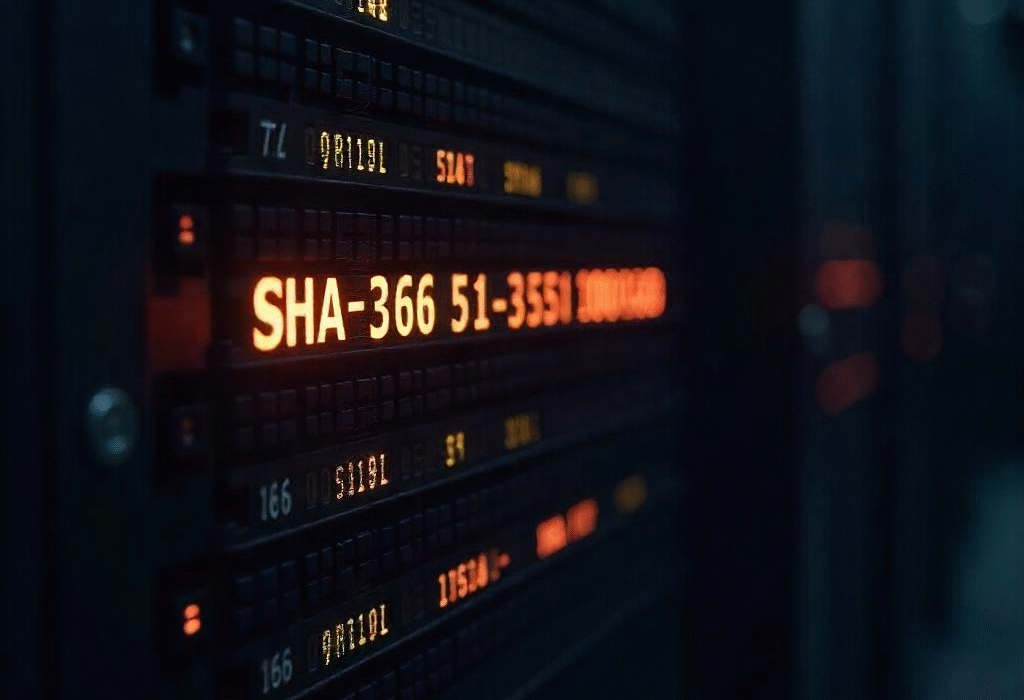In the intricate architecture of blockchain technology, a fundamental concept that underpins its security and integrity is cryptographic hashing. Often hailed as the “backbone of blockchain security,” hashing is a sophisticated mathematical process that transforms any input data into a fixed-size string of characters, known as a hash value or simply a “hash.” This article will demystify cryptographic hashing, explaining its mechanics, its pivotal role in blockchain, and its broader applications, making this complex topic accessible to those with minimal technical background.
Summary
- What is Cryptographic Hashing?
- When and How Does Hashing Occur in Blockchain?
- The Role of Hashing in Blockchain Security
- Core Characteristics of Cryptographic Hash Functions
- Why the words "Hash" and "Cryptographic"
- The Power of Hashing: Uniqueness and Data Reliability
- No Hashing, No Blockchain: Why It's Essential
- Hashing Beyond Blockchain: Diverse Applications
- The Genesis of Hashing and Its Uniqueness
- How Hashing Creates "Unique" Data Sets and Their Security
- What Happens to Data After Hashing?
What is Cryptographic Hashing?
Imagine you have a document – it could be a simple word, a long paragraph, or even an entire book. Now, imagine a special machine that can take this document, no matter how big or small, and instantly produce a unique, short code for it. This code is always the same length, regardless of the document’s size. Even more impressively, if you change just one single character in the original document, the machine will produce a completely different code. This magical machine is a simplified analogy for a cryptographic hash function, and the code it produces is the cryptographic hash.
In the context of blockchain:
- Cryptographic Hashing: The process of taking any digital data (like a transaction, a block of transactions, or even an entire file) and running it through a special mathematical algorithm.
- Cryptographic Hash: The unique, fixed-size output (the “code” or “digital fingerprint”) generated by the hashing process.
The “cryptographic” part emphasizes that these hash functions are specifically designed to be extremely secure and resistant to manipulation. They are one-way functions, meaning it’s easy to calculate the hash from the data, but practically impossible to reverse-engineer the original data from the hash.
When and How Does Hashing Occur in Blockchain?
Hashing is an incessant and fundamental operation within a blockchain. It occurs at several critical junctures:
- For Individual Transactions: Every transaction (e.g., sending Bitcoin from Bridget to Alex) is first hashed. This creates a unique identifier for that specific transaction.
- For Blocks: A blockchain is, as its name suggests, a chain of “blocks.” Each block contains a collection of verified transactions. Before a new block is added to the chain, all the data within that block (including the list of transactions, a timestamp, and the hash of the previous block) is hashed. This generates the unique hash for the current block.
- During Mining/Validation: In proof-of-work blockchains like Bitcoin, “miners” compete to find a specific hash for the new block that meets certain criteria (e.g., starts with a certain number of zeros). This process, known as “mining,” involves repeatedly hashing the block data with a changing piece of information (called a “nonce”) until the target hash is found.
How the Hashing Happens (Simplified):
Imagine a complex mathematical blender. You throw in all the raw ingredients (transaction data, previous block’s hash, timestamp, etc.). The blender whirs, performs incredibly complex calculations, and out comes a perfectly blended, fixed-size smoothie – the hash. This process is instantaneous for a computer, but the calculations behind it are designed to be computationally intensive to prevent cheating.
The Role of Hashing in Blockchain Security
The cryptographic hash contributes to blockchain security in profound ways, serving as its primary guardian against data manipulation and ensuring the chain’s integrity:
- Immutability and Tamper-Proofing: This is the most critical function. Each block in a blockchain contains the hash of the previous block. This creates a chronological and immutable chain. If someone were to try and alter even a single transaction in an old block, that change would immediately alter the hash of that block. Since the altered block’s hash would no longer match the “previous hash” stored in the next block, the chain would break. This invalidation would be instantly detected by the network, rendering the attempted alteration useless. It’s like a digital seal on each block, where breaking one seal alerts everyone.
- Data Integrity Verification: Hashing allows for quick and easy verification of data. If you have a hash of a file, and someone sends you that file, you can re-hash the received file. If your calculated hash matches the original hash, you know the file hasn’t been tampered with. This is crucial for ensuring that transactions and block data haven’t been corrupted or maliciously changed.
- Proof of Work (in Bitcoin): In Bitcoin’s system, miners have to expend significant computational power to find a valid hash for a new block. This “work” makes it extremely costly and difficult for any single entity to control or manipulate the network, as they would need to outpace the collective computing power of all other miners. This ensures the integrity and security of the entire network.

Core Characteristics of Cryptographic Hash Functions
To be effective in blockchain, cryptographic hash functions must possess several fundamental properties:
- Determinism: The same input will always produce the exact same hash output. Always.
- Fixed-Size Output: Regardless of the input size, the hash output will always be of a fixed length (e.g., The hashing function SHA-256 always produces a 256-bit hash, which looks like a 64-character hexadecimal string).
- One-Way Function (Pre-image Resistance): It’s computationally infeasible to reverse the hashing process; you cannot figure out the original input data just by looking at its hash.
- Collision Resistance: It’s extremely difficult (practically impossible) to find two different inputs that produce the same hash output. While collisions mathematically exist (since there are more possible inputs than outputs of a fixed size), finding one for a strong cryptographic hash function is computationally unfeasible.
- Avalanche Effect: Even a tiny change in the input data (e.g., changing a single letter or number) results in a drastically different hash output. This sensitivity is vital for detecting tampering.
Why the words “Hash” and “Cryptographic”
The term “hash” itself refers to the idea of “chopping up and mixing” data into a complex, uniform output, much like how a chef might “hash” ingredients together. It evokes the idea of transforming a larger, diverse input into a consistent, condensed form.
The term “cryptographic” signifies that the hash function is specifically designed with strong security properties that make it suitable for cryptographic applications. This includes the one-way nature and collision resistance that are essential for data integrity and security in systems like blockchain. Without the “cryptographic” aspect, a simple hash function might not be secure enough for sensitive data verification.
The Power of Hashing: Uniqueness and Data Reliability
The robustness of hashing is what truly underpins the reliability of blockchain data. It brings a unique and indispensable quality that no other single mechanism can fully replace.
Hashing provides immutable data linking and verifiable integrity across the entire chain, and it’s indispensable for the blockchain’s operation.
- Chain of Trust: The cryptographic link between blocks, forged by including the previous block’s hash in the current one, creates an undeniable chain of trust. Each block is cryptographically sealed to the one before it. Without this linkage, the blockchain would merely be a disorganized collection of independent blocks, susceptible to easy manipulation.
- Resistance to Retroactive Tampering: This is hashing’s unparalleled contribution. If someone were to change a transaction in a block from last year, not only would the hash of that specific block change, but it would also invalidate the hash of every subsequent block in the chain because they all refer back to the original (now incorrect) hash. To successfully alter one block, an attacker would have to re-mine not only that block but every single block that has been added since then – an impossible task for a decentralized network with significant computing power.
No Hashing, No Blockchain: Why It’s Essential
In the absence of cryptographic hashing, or if it ceased to function as designed, the blockchain as we know it would fundamentally fail:
- No Immutability: Transactions could be altered retroactively without detection. The entire history of the blockchain would be unreliable and subject to change.
- No Security Against Tampering: An attacker could easily modify transaction records, creating fraudulent transactions or reversing legitimate ones.
- No Consensus: Without a cryptographic link between blocks, it would be impossible for network participants to agree on the correct version of the ledger. Forks (divergent versions of the chain) would be rampant, and trust in the system would collapse.
- No Proof of Work (for relevant blockchains): The mining process, which relies on finding specific hashes, would not exist, undermining the security and decentralization of networks like Bitcoin.
In essence, without hashing, the blockchain would lose its defining characteristics of security, transparency, and trustlessness, rendering it useless for secure record-keeping or financial transactions.

Hashing Beyond Blockchain: Diverse Applications
Cryptographic hashing is not exclusive to blockchain. Its unique properties make it invaluable in numerous other domains:
- Password Storage: When you create an account online, your password isn’t typically stored directly. Instead, a hash of your password is stored. When you try to log in, the system hashes the password you enter and compares it to the stored hash. If they match, you’re authenticated. This protects your actual password in case of a data breach, as hackers would only get the hashes, not the original passwords.
- Data Integrity and File Verification:
- Software Downloads: When you download software, the provider often provides a hash (e.g., MD5 or SHA-256 checksum). After downloading, you can generate a hash of the file on your computer and compare it to the provided hash. If they match, you can be confident that the file hasn’t been corrupted during download or tampered with by a malicious third party.
- Cloud Storage: Cloud providers use hashing to quickly identify duplicate files and verify the integrity of data stored on their servers.
- Digital Signatures: Hashing is a core component of digital signatures. Instead of signing an entire large document, a hash of the document is signed. This hash acts as a unique summary. The signature then verifies both the authenticity of the signer and the integrity of the document (that it hasn’t changed since it was signed).
- Databases and Data Indexing: Hashing is used to create “hash tables” for efficient data retrieval. By hashing a piece of data (like a name), it can be quickly directed to a specific location in memory, speeding up search operations.
The Genesis of Hashing and Its Uniqueness
Hashing, in its basic form, has been around in computer science for decades, primarily for data indexing and error checking. However, the specific discipline of cryptographic hashing as we know it today evolved with the increasing need for secure data integrity and authentication in digital systems.
Before cryptographic hashing became prevalent, data integrity was often maintained through simpler checksums or message authentication codes (MACs) that were not cryptographically robust. These methods could be more easily tampered with or reversed. Cryptographic hashing provided a superior, provably secure method that could withstand malicious attempts at manipulation.
The creation of early cryptographic hash functions like MD5 and SHA-1 (though now considered less secure for certain applications due to discovered vulnerabilities) paved the way for more robust algorithms like SHA-256 and SHA-3, which are foundational to modern security systems, including blockchain.
How Hashing Creates “Unique” Data Sets and Their Security
The “uniqueness” of a hash stems from the avalanche effect and collision resistance.
Step-by-step example with a simplified analogy:
Imagine our “data” is a phrase: “Hello World!”
- Input: The phrase “Hello World!”.
- Hashing Function: A cryptographic algorithm (like SHA-256).
- Process: The algorithm takes each character, converts it into binary, performs complex mathematical operations (bit shifts, additions, modular arithmetic, etc.) on blocks of data, and iteratively mixes and squashes the data.
- Output (Hash): A fixed-length string, for example: a591a6d40bf420404a011733cfb7b190d62c65bf0bcda32b57b277d9ad9f146e
Now, let’s change just one tiny thing: “Hello World!” to “hello World!” (lowercase ‘h’).
- New Input: “hello World!”
- Hashing Function: Same algorithm.
- Process: The same complex operations, but because the initial input bit stream is different, the cascading calculations produce a vastly different result.
- New Output (Hash): 2c7b50877995186b59523d4e0e417122b51688ac5227d8487b46944e803c7375
Notice how a single letter change resulted in a completely different and seemingly random hash. This illustrates the avalanche effect.
What Happens to Data After Hashing?
The original data remains exactly as it was. The hashing process does not alter the original data. It merely creates a unique “fingerprint” or “summary” of that data. The hash is then used for verification or as a component in a larger data structure (like a blockchain block).
Concrete Blockchain Example:
- Transaction Data: Bridget sends 1 BTC to Alex.
- Hash 1 (Transaction Hash): A unique hash is generated for this specific transaction.
- Block Creation: Many such transactions are bundled into a block. The previous block’s hash is also included, along with a timestamp and a “nonce” (a random number miners try to find).
- Hash 2 (Block Hash): All this bundled data is hashed together to create the unique hash for the current block. This Block Hash is what identifies the block and gets included in the next block, linking the chain.
The security comes from the fact that it’s practically impossible to create two different sets of transactions that would produce the same block hash, or to modify an existing transaction without changing the hash and thus breaking the chain.
What Does a Hash Look Like?
A cryptographic hash is typically a string of hexadecimal characters (0-9 and A-F). Its length depends on the specific hashing algorithm used.
For example, a SHA-256 hash (widely used in Bitcoin) is always 256 bits long, which translates to 64 hexadecimal characters.
a591a6d40bf420404a011733cfb7b190d62c65bf0bcda32b57b277d9ad9f146e (This is the SHA-256 hash of "Hello World!")Analogies: IP Address, Fingerprints, and Blockchain Hash
The concept of a unique identifier is common across various domains:
- IP Address: An Internet Protocol (IP) address uniquely identifies a device on a network (like a computer or smartphone). It tells you where a device is located on the internet, allowing data to be sent to it.
- Fingerprints: Human fingerprints are unique biometric identifiers. No two people have the exact same fingerprint, making them excellent for individual identification. They are a physical characteristic that uniquely identifies a person.
- Blockchain Hash: A blockchain hash is a unique digital fingerprint of a piece of data (a transaction, a block, or a file). It tells you what the data is and whether it has been altered.
The analogy between an IP address, a fingerprint, and a blockchain hash lies in their function as unique identifiers.
- An IP address is an address that identifies a location on a network.
- A fingerprint is a physical marker that identifies an individual.
- A blockchain hash is a digital signature that identifies data integrity.
Each serves to uniquely pinpoint something within its respective system, whether it’s a network location, a person, or the state of digital information. The hash, in particular, is the ultimate guardian of data integrity and the core component that makes the blockchain a trustworthy and immutable record-keeping system.



